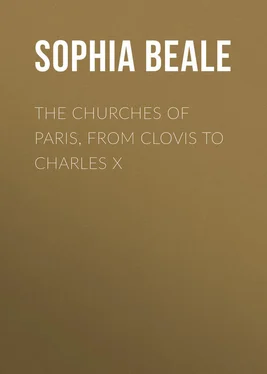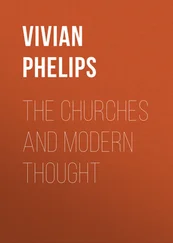Sophia Beale - The Churches of Paris, from Clovis to Charles X
Здесь есть возможность читать онлайн «Sophia Beale - The Churches of Paris, from Clovis to Charles X» — ознакомительный отрывок электронной книги совершенно бесплатно, а после прочтения отрывка купить полную версию. В некоторых случаях можно слушать аудио, скачать через торрент в формате fb2 и присутствует краткое содержание. Жанр: foreign_antique, foreign_prose, на английском языке. Описание произведения, (предисловие) а так же отзывы посетителей доступны на портале библиотеки ЛибКат.
- Название:The Churches of Paris, from Clovis to Charles X
- Автор:
- Жанр:
- Год:неизвестен
- ISBN:нет данных
- Рейтинг книги:3 / 5. Голосов: 1
-
Избранное:Добавить в избранное
- Отзывы:
-
Ваша оценка:
- 60
- 1
- 2
- 3
- 4
- 5
The Churches of Paris, from Clovis to Charles X: краткое содержание, описание и аннотация
Предлагаем к чтению аннотацию, описание, краткое содержание или предисловие (зависит от того, что написал сам автор книги «The Churches of Paris, from Clovis to Charles X»). Если вы не нашли необходимую информацию о книге — напишите в комментариях, мы постараемся отыскать её.
The Churches of Paris, from Clovis to Charles X — читать онлайн ознакомительный отрывок
Ниже представлен текст книги, разбитый по страницам. Система сохранения места последней прочитанной страницы, позволяет с удобством читать онлайн бесплатно книгу «The Churches of Paris, from Clovis to Charles X», без необходимости каждый раз заново искать на чём Вы остановились. Поставьте закладку, и сможете в любой момент перейти на страницу, на которой закончили чтение.
Интервал:
Закладка:
Two charters dated Paris, 1245, and Aigues-Mortes, 1248, respectively give the terms of the endowment by the king. The number of ecclesiastics who first formed the college was fixed at twenty-one; five principal priests or maîtres chapelains , each having an assistant chaplain (a priest), and a deacon, and three beadles who had as many clerks under them. The number was modified from time to time, during five centuries, and latterly it consisted of a treasurer, twelve canons, and nineteen chaplains. The office of treasurer was generally filled by some important personage, and he had the privilege of wearing the mitre and other insignia of the episcopate, and of giving the Benediction upon great festivals; but he was not allowed to bear the crozier.
The most important event of the 13th century connected with the Sainte-Chapelle was the translation of some of S. Louis' bones from S. Denis, in which church they had been laid twenty-seven years previously upon their arrival from Tunis, where the king had died of fever on the 25th August, 1270. Feeling his last moments to have arrived, he caused his body to be placed upon a bed of ashes, and wearing the habit of the third order of S. Francis, his noble spirit passed away. He was embalmed, according to the fashion of the day; or rather, his bones were relieved of their outer casements, by boiling in wine and water; other parts of his body, which it is unnecessary to specify, being given by his son to the King of Sicily, who placed them in the church of Monreale, Palermo. The young Comte de Nevers had died just before S. Louis; and Alfonso de Brienne, Comte d'Eu, son of John de Brienne, King of Jerusalem, and the Chevalier Pierre, the King's chamberlain, had also succumbed to the unhealthy climate. The funeral procession set out, and wended its way towards France under the care of S. Louis' son, Philippe le Hardi. Arriving at Paris, the bodies were placed temporarily in Notre-Dame on the 21st of May; and the next day, amidst a large concourse of people, the procession, consisting of clergy, and religious, started early for S. Denis, Philippe, reverently bearing his father's bones, walking like the rest. Up through the city they went, singing and chanting, and taking much the same route as had been traversed by S. Denis and his companions, after their martyrdom, as recorded by the old chroniclers. In an engraving by Boulogne a long procession of monks and knights is seen issuing from the abbey to meet another coming from Paris, the king and bishops being dressed in that peculiar high wind-blown drapery common to pictorial art in the 17th and 18th centuries. S. Louis' bones were placed in a stone coffin and buried in front of the altar of the Holy Trinity, near the resting place of the bodies of Louis VIII. and Philippe Auguste. Philippe le Hardi's wife, Isabelle, and Tristan, Comte de Nevers, were placed on the right; the chevalier Pierre, who, as chamberlain, had the privilege of sleeping in the King's chamber, was laid at his feet. In 1292, Henri de Luxembourg caused the relics to be placed in a silver shrine and conveyed to the Sainte-Chapelle by the Archbishops of Reims and Lyon; but after some days they were returned to S. Denis, and it was not until 1306 that Philippe le Bel succeeded in his desire of placing the remains of his grandfather in the chapel which was so dear to him, that he felt a malaise each time he heard the divine offices elsewhere. The Bull of canonization was promulgated by Pope Boniface VIII. in 1297, and the translation of the king's skull followed nine years later, accompanied by all the picturesque pomp of the 14th century. The reliquary was in the form of a gold bust of natural size, enriched with precious stones, and supported by Angels upon a pedestal which rested upon four silver-gilt lions. The crown and the collar of the vestment were decorated with rubies, pearls, emeralds, and sapphires; and around the socle were representations of the twenty-nine kings of France, and a Latin inscription giving the date of the work, and the name of the smith, Master Guillaume Juliani. Such was the châsse which enclosed the principal relic of S. Louis: "Afin que la présence du Chef de ce grand roi, qui pendant sa vie avait eu la justice en singulière recommandation, animat les Juges de ce Parlement à maintenir les loix, protéger les gens du bien, rendre la justice à ses sujets sans exception de personne." 3 3 The bust was given to the chapel by Philippe le Bel in 1304. Another, of silver-gilt, containing the upper part of the head, used to be at the Abbey of Poissy. The little church of la Montjoie rejoices in a portion of the sainted king's hand, enclosed in a 14th century reliquary; and the cathedral of Meaux possesses a chalice said to have belonged to him.
L'an mil et trois cens et six ans,
Ot à Paris joie nouvele,
Car li rois mit en sa chapele,
Que S. Loys fist tele faire
Qu'a tout le monde devroit plaire,
Le chief de lui si richement
Et si très-honorablement,
Que par raison de la bel euvre
Que li dons saintuaire queuvre
Le vessel où l'en la mis prisent
Toutes personnes qui l'avisent. (Guil. Guiart.)
On the 15th May, 1843, an interesting discovery was made in the chapel. Some workmen, in removing a stone of the pavement of the apse, discovered a tin box containing the remains of a heart, and a procès-verbal , stating that it had been previously found on the 21st January, 1803. Although the position of the box (the centre of the apse) indicated that it had belonged to some distinguished person, yet there was no clue to its owner, neither inscription, nor name, nor date. The box, it is true, was in the style of the 13th century; but it seemed doubtful, that, had the heart been S. Louis', such an important relic should have been lost sight of, and no record of it given by the Benedictines at S. Denis in their inventory of the treasures which they had received from the Sainte-Chapelle. The matter was referred to the Academie des Inscriptions et Belles Lettres, and fully discussed; but the members could arrive at no decision, and consequently the box was replaced where it had been found.
While the kings resided in the old Cité, the most brilliant ceremonies succeeded one another at the Sainte-Chapelle; it was, in fact, the chapel belonging to the adjoining palace, now the Palais de Justice. The Queens, Marie de Brabant, second wife of Philippe le Hardi; Marie de Luxembourg, second wife of Charles le Bel; Jeanne d'Evreux, third wife of the same Prince; and Isabelle de Bavière, wife of Charles VI., were all crowned there. The marriage of the Emperor, Henri VII. and Marguerite de Brabant, and the betrothal of Isabeau, eldest daughter of Charles VI. with Richard II. of England, were also solemnised in the chapel. There, in 1332, Philippe de Valois held a great assembly of prelates and barons, to announce his project of another crusade against the Infidels – a project which was never carried out. On the feast of the Epiphany, 1378, King Charles V., the Emperor Charles IV., and his son Wenceslas, King of the Romans, offered gold, frankincense and myrrh, after the manner of the three holy Magi. Every time that the sovereigns convoked an assemblage of the clergy in the palace, the prelates first went to the chapel and asked the blessing of the Holy Spirit, while prostrated before the relics. In 1483, when Louis XI. was lying ill at Tours, he hoped to prolong his life by surrounding himself with the most sacred relics of his kingdom – so reluctant was this devôt to depart from our wicked world. The Sainte Ampoule was brought by the religious of S. Remi from Reims; the canons of the Sainte-Chapelle took the Cross of Victory and the Rod of Moses out of their treasury, and a grand procession of clergy and laity was formed on the 1st of August to carry them from Paris to Plessis-les-Tours. But, alas! to no end; for on the 30th of the same month the poor creature finished his earthly career of hypocrisy.
Читать дальшеИнтервал:
Закладка:
Похожие книги на «The Churches of Paris, from Clovis to Charles X»
Представляем Вашему вниманию похожие книги на «The Churches of Paris, from Clovis to Charles X» списком для выбора. Мы отобрали схожую по названию и смыслу литературу в надежде предоставить читателям больше вариантов отыскать новые, интересные, ещё непрочитанные произведения.
Обсуждение, отзывы о книге «The Churches of Paris, from Clovis to Charles X» и просто собственные мнения читателей. Оставьте ваши комментарии, напишите, что Вы думаете о произведении, его смысле или главных героях. Укажите что конкретно понравилось, а что нет, и почему Вы так считаете.




![Theresa Cheung - The Dream Dictionary from A to Z [Revised edition] - The Ultimate A–Z to Interpret the Secrets of Your Dreams](/books/692092/theresa-cheung-the-dream-dictionary-from-a-to-z-r-thumb.webp)







